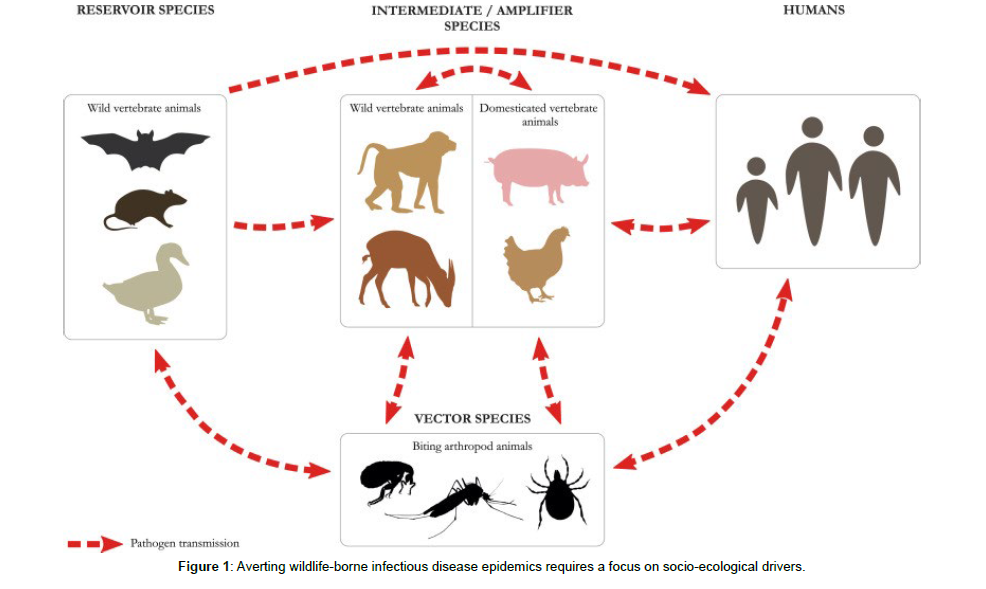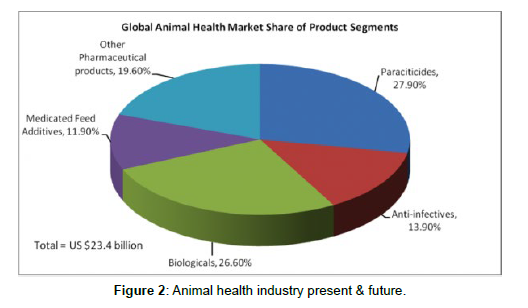Veterinary Epidemiology: Protecting Animal Health and Promoting Public Health
Received: 03-Jul-2023 / Manuscript No. JCPHN-23-106821 / Editor assigned: 05-Jul-2023 / PreQC No. JCPHN-23-106821 (PQ) / Reviewed: 19-Jul-2023 / QC No. JCPHN-23-106821 / Revised: 22-Jul-2023 / Manuscript No. JCPHN-23-106821 (R) / Published Date: 29-Jul-2023 DOI: 10.4172/2471-9846.1000435
Abstract
Veterinary epidemiology is a specialized field that plays a critical role in safeguarding animal health, improving animal welfare, and protecting public health. It involves the study of diseases in animal populations, analysing their causes, patterns of occurrence, and implementing preventive measures. By understanding the dynamics of diseases in animals and their potential impact on human health, veterinary epidemiologists contribute to the development of effective strategies for disease prevention, surveillance, and control. In this article, we will explore the significance of veterinary epidemiology, its key principles, and its vital role in promoting the well-being of animals and humans alike.
Keywords
Veterinary epidemiology; Animal health; Patterns of disease
Introduction
Veterinary epidemiology focuses on understanding the occurrence, distribution, and determinants of diseases in animal populations. It involves the application of epidemiological principles and methods to investigate and analyse patterns of disease, evaluate risk factors, and develop strategies to prevent and control disease outbreaks [1, 2].
Methodology
Key principles of veterinary epidemiology
Veterinary epidemiologists monitor animal populations for signs of diseases, conducting surveillance to detect outbreaks and identify patterns of disease occurrence. This allows for early detection, rapid response, and the implementation of control measures.
Risk assessment
Assessing the risks associated with diseases is crucial for developing preventive strategies. Veterinary epidemiologists evaluate the likelihood of disease introduction or spread, identify high-risk populations or areas, and make informed recommendations for risk mitigation.
Investigation and research
Investigating disease outbreaks is an integral part of veterinary epidemiology. Epidemiologists collect data, conduct studies, and analyse information to determine the source, transmission dynamics, and risk factors associated with specific diseases. This knowledge aids in preventing future outbreaks [3-6].
Disease modelling and forecasting
By utilizing mathematical models, veterinary epidemiologists can simulate disease spread and forecast potential scenarios. These models help inform decision-making, resource allocation, and the development of effective intervention strategies.
Importance of veterinary epidemiology
Veterinary epidemiology plays a crucial role in protecting animal populations from diseases. It helps identify risk factors, implement preventive measures, and control disease outbreaks. By addressing diseases in animals, veterinary epidemiology contributes to improving animal health and welfare.
Public health
Many diseases can be transmitted between animals and humans, known as zoonotic diseases. Veterinary epidemiology provides insights into zoonotic diseases, their transmission pathways, and preventive strategies. By managing diseases in animals, it helps protect human health and prevent potential public health crises [7,8].
Food safety and security
Diseases in livestock can have significant implications for food safety and security. Veterinary epidemiologists work to ensure the safety of the food supply by monitoring disease prevalence, implementing control measures, and establishing protocols for food safety.
One health approach
Veterinary epidemiology is an integral part of the One Health approach, which recognizes the interconnectedness of human, animal, and environmental health. By addressing diseases in animals, veterinary epidemiology contributes to a holistic understanding of health and fosters collaboration between veterinary, medical, and environmental professionals [9,10].
Veterinary epidemiology plays a vital role in protecting animal health, improving animal welfare, and safeguarding public health. By studying disease patterns, analyzing risk factors, and implementing preventive measures, veterinary epidemiologists contribute to disease control, surveillance, and the overall well-being of animals and humans. Their work not only enhances our understanding of diseases but also helps develop strategies to prevent and manage outbreaks, ensuring a healthier future for both animals and the communities they coexist with (Figure 1).
Veterinary epidemiology plays a critical role in understanding and controlling the spread of diseases that affect animals. By investigating the patterns, causes, and effects of diseases within animal populations, veterinary epidemiologists contribute to the protection of animal health, welfare, and public health. In this article, we will delve into the field of veterinary epidemiology, exploring its significance, methodologies, and the impact it has on both animal and human populations.
Veterinary epidemiology is the study of diseases in animal populations, encompassing their occurrence, distribution, and determinants. It involves the systematic collection, analysis, and interpretation of data to identify patterns and risk factors associated with diseases. Veterinary epidemiologists employ various research methods, including observational studies, disease surveillance, mathematical modelling, and outbreak investigations, to generate valuable insights. Through active surveillance and monitoring, veterinary epidemiologists detect and track the occurrence of diseases in animal populations. This knowledge is crucial for developing control and prevention strategies, including vaccination programs, quarantine measures, and biosecurity protocols [11].
Many diseases affecting animals have the potential to transmit to humans, posing significant public health risks. Veterinary epidemiology plays a vital role in identifying zoonotic diseases, assessing their transmission pathways, and implementing interventions to prevent their spread, protecting both animal and human populations.
By understanding disease patterns and risk factors, veterinary epidemiologists contribute to the development of effective strategies for disease prevention, early detection, and treatment. This supports the overall welfare and health management of animals, promoting their well-being and reducing suffering (Figure 2).
Veterinary epidemiology is closely aligned with the One Health concept, recognizing the interconnectedness of animal, human, and environmental health. By studying diseases in animal populations,veterinary epidemiologists contribute to a holistic understanding of health and facilitate collaborative efforts between veterinary, medical, and environmental professionals. Veterinary epidemiologists utilize surveillance systems to collect data on disease occurrence, allowing for early detection and timely response. These systems may involve laboratory testing, reporting from veterinary clinics and diagnostic laboratories, or integration of data from multiple sources [12, 13].
Discussion
Veterinary epidemiologists assess and quantify the risks associated with specific diseases or factors that contribute to disease occurrence. This information guides the development of targeted prevention and control measures to mitigate those risks effectively. During disease outbreaks, veterinary epidemiologists investigate the source, mode of transmission, and factors contributing to the spread of the disease. This involves conducting field studies, collecting samples, and analysing data to inform control measures and prevent further transmission. Mathematical modelling enables veterinary epidemiologists to simulate disease dynamics and predict the potential impact of interventions. Models help in understanding disease transmission patterns, evaluating the effectiveness of control strategies, and informing decision-making processes.
Conclusion
Veterinary epidemiology is a vital field that combines the principles of epidemiology with a focus on animal populations. It serves as a cornerstone in safeguarding animal health, ensuring animal welfare, and protecting public health from zoonotic diseases. Through surveillance, outbreak investigations, modeling, and risk assessment, veterinary epidemiologists generate valuable insights that inform evidencebased strategies for disease prevention, control, and management. By recognizing the interdependence of animal and human health, veterinary epidemiology plays a crucial role in promoting the wellbeing of both animals and the communities they inhabit.
References
- Breman JG, Henderson DA (2002) Diagnosis and management of smallpox. N Engl J Med 346:1300-1308.
- Damon IK (2011) Status of human monkeypox: clinical disease, epidemiology and research. Vaccine 29: D54-D59.
- Ladnyj ID, Ziegler P, Kima E (2017) A human infection caused by monkeypox virus in Basankusu Territory, Democratic Republic of the Congo. Bull World Health Organ 46: 593.
- Olson VA, Laue T, Laker MT, Babkin IV, Drosten C, et al. (2019) Real-time PCR system for detection of orthopoxviruses and simultaneous identification of smallpox virus. J Clin Microbiol 42: 1940-1946.
- MacNeil A, Reynolds MG, Braden Z , Carroll DS, Bostik V, et al (2009) Transmission of atypical varicella-zoster virus infections involving palm and sole manifestations in an area with monkeypox endemicity. Clin Infect Dis 48: 6-8.
- Di Giulio DB, Eckburg PB (2004) Human monkeypox: an emerging zoonosis. Lancet Infect Dis 4: 15-25.
- Ježek Z, Szczeniowski M, Paluku KM, Moomba M (2000) Human monkeypox: clinical features of 282 patients. J Infect Dis 156: 293-298.
- Kulesh DA, Loveless BM, Norwood D, Garrison J, Whitehouse CA, et al. (2004) Monkeypox virus detection in rodents using real-time 3′-minor groove binder TaqMan assays on the Roche LightCycler. Lab Invest 84: 1200-1208.
- Breman JG, Steniowski MV, Zanotto E, Gromyko AI, Arita I (1980) Human monkeypox, 1970-79. Bull World Health Organ 58: 165.
- Karem KL, Reynolds M, Braden Z, Lou G, Bernard N, et al. (2005) Characterization of acute-phase humoral immunity to monkeypox: use of immunoglobulin M enzyme-linked immunosorbent assay for detection of monkeypox infection during the 2003 North American outbreak. Clin Diagn Lab Immunol 12: 867-872.
- Andrew RM (2018) Global CO2 emissions from cement production. Earth Syst Sci Data 10:195-217.
- Metz B, Davidson O, de Coninck H (2005) Carbon Dioxide Capture and Storage. Intergovernmental Panel on Climate Change New York: Cambridge University Press.
- Umar M, Kassim KA, Chiet KTP (2016) Biological process of soil improvement in civil engineering: A review. J Rock Mech Geotech Eng 8:767-774.
Indexed at, Google Scholar, Crossref
Indexed at, Google Scholar, Crossref
Indexed at , Google Scholar, Crossref
Indexed at , Google Scholar, Crossref
Indexed at, Google Scholar, Crossref
Indexed at, Google Scholar, Crossref
Indexed at, Google Scholar, Crossref
Indexed at, Google Scholar, Crossref
Citation: Nicolson E (2023) Veterinary Epidemiology: Protecting Animal Healthand Promoting Public Health. J Comm Pub Health Nursing, 9: 435. DOI: 10.4172/2471-9846.1000435
Copyright: © 2023 Nicolson E. This is an open-access article distributed underthe terms of the Creative Commons Attribution License, which permits unrestricteduse, distribution, and reproduction in any medium, provided the original author andsource are credited.
Share This Article
Recommended Journals
Open Access Journals
Article Tools
Article Usage
- Total views: 423
- [From(publication date): 0-2023 - Dec 17, 2024]
- Breakdown by view type
- HTML page views: 354
- PDF downloads: 69


